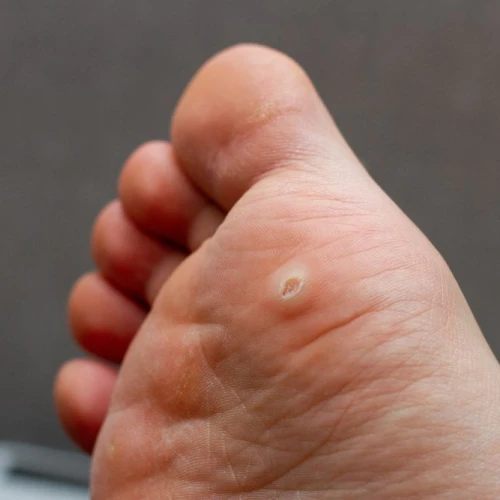What is a plantar wart?1, 2
A plantar wart is a benign skin lesion caused by the human papillomavirus (HPV). Its features include a small, rough and well-defined bump (if a single wart) usually located on the sole of the foot. Plantar warts generally form on the weight-bearing areas of the feet (forefoot, heel, etc.). There are two types of plantar warts: single plantar warts and multiple plantar warts in a mosaic pattern.
Single plantar warts
As the name suggests, this type of wart occurs as a single wart or a small number of warts. Plantar warts are deep-seated and clearly delimited by a horny ring (thickened skin). Blackish dots, which are actually blood vessels, can be seen at their centre. A single plantar wart can cause pain when walking due to the pressure exerted by the body’s weight.
Multiple mosaic plantar warts
Unlike single plantar warts, multiple mosaic plantar warts appear as patches of thickened skin resembling a mosaic. They are much less painful than a single plantar wart.
Plantar warts are relatively common in children. They can cause discomfort but, fortunately, are easily treatable thus preventing complications. However, they are much rarer in adults in whom they are more often located in the forefoot area, under the nails or around the toes, and also in non-weight-bearing areas. This is also the case with mosaic warts, which can occur on the foot or elsewhere.
Symptoms: how do you know if you have a wart or not?2
The first symptom is pain when walking and the horny ring that forms around the wart. Another characteristic sign of a wart on the foot is the presence of small black dots corresponding to dilated tiny blood vessels. These small vessels can sometimes bleed.
If a painful plantar wart is left untreated, redness may appear around the wart or it can be painful, and this pain may radiate to other areas including the entire foot, the leg or, in more serious cases, under the toenails. If a wart is left untreated, this can lead to poor posture to avoid being in pain when walking. This poor posture can in turn lead to muscular contractions, joint pain and, over the longer term, if left untreated, cause major disruptions to postural balance.
Mosaic warts are easily recognised as their appearance consists of superficial warts grouped together in patches. Unlike single warts, mosaic warts cause very little pain.
What is the difference between a plantar wart and a corn on your foot?1
A plantar wart differs from a corn in a number of ways:
- Plantar warts are painful while corns are not (they are only sensitive when pressed).
- There are small blood vessels visible at the centre of the wart, but these are absent on a corn.
- The natural lines on the skin are disrupted with a plantar wart, which is not the case with a corn.
Causes: why have I got a wart on my foot?1
A plantar wart is a benign condition caused by a virus. It appears when the skin has been infected by one of the types of the Human Papillomavirus. These viruses penetrate the skin through breaches in the protective layer of the skin such as a skin wound or very dry skin.
Are plantar warts contagious?1, 2
Warts on the feet are highly contagious. However, the risk of being infected is low because transmission requires an entry point for the virus (microtrauma, cut, blister). In most cases, people with warts on their feet are infected after walking barefoot on infected floors (sports halls, communal showers, public swimming pools, etc.). Note that plantar warts occur more easily after bathing in hot water, as this tends to soften the stratum corneum on the feet. Communal situations (in schools, for example) are also a factor in viral transmission. This explains why children are more affected by plantar warts. Other contributing factors are excessive sweating of the feet and immuno-depression.
How do you treat and get rid of a wart on your foot?2, 3, 4
In most cases, warts on the foot will disappear spontaneously in healthy individuals. It can take a few months to a maximum of two years. Several solutions are available if you want to get rid of a plantar wart as it is causing you pain or simply because it is unsightly.
Self-medication and over-the-counter products sold in chemists
These products may contain Salicylic acid, trichloroacetic acid or Formic Acid which are used to exfoliate the wart and destroy the area of skin infected by HPV. They have a stripping action. They are applied directly to the wart every day until the lesion has disappeared completely. Treatment usually lasts for 4 to 8 weeks.
Pumice stone
A pumice stone can be used to reduce the size of the plantar wart and help it to reabsorb.
If the products sold in chemists are not effective on the wart, you will need to see a pedicurist/podiatrist or dermatologist. Podiatrists can remove warts provided they do not exceed 2 mm in diameter. If the wart is over 2 cm in diameter, only a dermatologist is qualified to treat it.
Cryotherapy
A dermatologist or pedicurist/podiatrist can use liquid nitrogen (- 190°) to treat the wart. Cryotherapy consists of applying liquid nitrogen topically to freeze the wart and dislodge it from its base. Several sessions are generally required to avoid any recurrence.
Carbon dioxide laser
Plantar warts can be destroyed using a laser beam. This method requires a local anaesthetic and, in most cases, will leave a scar.
Surgical removal
Only dermatologists can use this technique, which requires making an incision to remove the wart. Surgical removal of single large warts is generally carried out under local anaesthetic. A painful scar can remain after the surgery.


